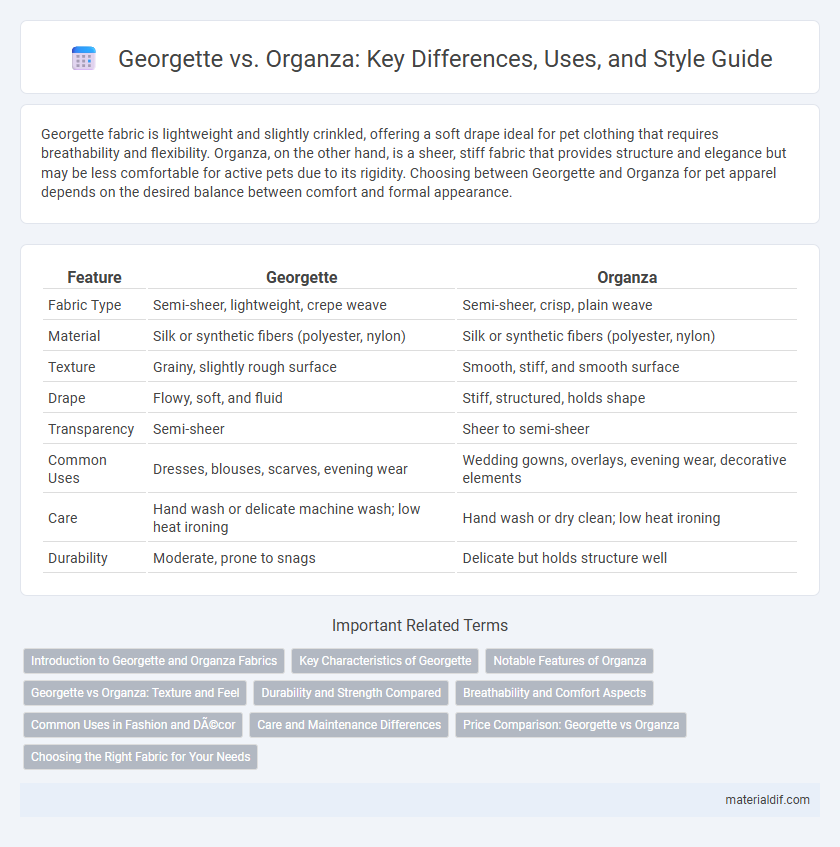Georgette fabric is lightweight and slightly crinkled, offering a soft drape ideal for pet clothing that requires breathability and flexibility. Organza, on the other hand, is a sheer, stiff fabric that provides structure and elegance but may be less comfortable for active pets due to its rigidity. Choosing between Georgette and Organza for pet apparel depends on the desired balance between comfort and formal appearance.
Table of Comparison
| Feature | Georgette | Organza |
|---|---|---|
| Fabric Type | Semi-sheer, lightweight, crepe weave | Semi-sheer, crisp, plain weave |
| Material | Silk or synthetic fibers (polyester, nylon) | Silk or synthetic fibers (polyester, nylon) |
| Texture | Grainy, slightly rough surface | Smooth, stiff, and smooth surface |
| Drape | Flowy, soft, and fluid | Stiff, structured, holds shape |
| Transparency | Semi-sheer | Sheer to semi-sheer |
| Common Uses | Dresses, blouses, scarves, evening wear | Wedding gowns, overlays, evening wear, decorative elements |
| Care | Hand wash or delicate machine wash; low heat ironing | Hand wash or dry clean; low heat ironing |
| Durability | Moderate, prone to snags | Delicate but holds structure well |
Introduction to Georgette and Organza Fabrics
Georgette fabric is a lightweight, sheer material made from silk or synthetic fibers, known for its soft, crinkled texture and excellent drape, often used in dresses and blouses. Organza is a thin, plain weave fabric made from silk or synthetic fibers, featuring a crisp, stiff texture that provides structure and volume, commonly used in evening wear and bridal gowns. Both fabrics offer distinct textures and finishes, with Georgette favored for its flow and Organza for its stiffness and shine.
Key Characteristics of Georgette
Georgette fabric is a lightweight, sheer material known for its slightly crinkled texture and excellent drape, making it ideal for flowy garments like dresses and blouses. Unlike organza, which is stiffer and more structured, georgette offers a soft, matte finish with a subtle grainy feel, enhancing comfort and breathability. Its resilience and ability to hold dye well make georgette popular for vibrant, elegant fashion designs.
Notable Features of Organza
Organza is a lightweight, sheer fabric characterized by its crisp texture and subtle sheen, made primarily from silk or synthetic fibers like polyester and nylon. Its notable features include excellent stiffness that maintains shape, slight transparency that adds elegance, and a delicate shimmer that enhances formal garments such as evening wear and bridal dresses. Organza's durability and smooth finish make it ideal for layered designs and decorative overlays, distinguishing it from softer fabrics like georgette.
Georgette vs Organza: Texture and Feel
Georgette fabric features a slightly crinkled, lightweight texture that delivers a soft and flowing feel, ideal for draped garments. In contrast, Organza boasts a crisp, sheer texture with a stiffer hand, providing structured shapes and volume in designs. The tactile difference lies in Georgette's matte finish versus Organza's smooth, glossy surface, influencing the fabric's use in fashion and decor.
Durability and Strength Compared
Georgette fabric is known for its lightweight, crepe-like texture, offering moderate durability with a slightly stretchy nature that resists tearing under regular wear. Organza, made from silk or synthetic fibers, boasts a stiffer, more structured weave, providing greater strength and resistance to abrasion compared to georgette. While georgette excels in drape and flow, organza is preferred for designs requiring sturdier fabric longevity and shape retention.
Breathability and Comfort Aspects
Georgette fabric offers superior breathability and lightweight comfort due to its loosely woven structure, allowing better air circulation which makes it ideal for warm climates. In contrast, Organza is stiffer and less breathable, often resulting in a more structured but less comfortable garment for extended wear. Choosing Georgette enhances comfort for everyday wear, while Organza suits occasions requiring a more formal, crisp appearance despite reduced airflow.
Common Uses in Fashion and Décor
Georgette is a lightweight, sheer fabric favored for flowy dresses, blouses, and scarves due to its soft drape and slightly crinkled texture, commonly seen in eveningwear and casual fashion. Organza, known for its crisp, stiff texture, is widely used in bridal gowns, evening dresses, and decorative overlays, providing structure and volume in both fashion and home decor such as curtains and table runners. Both fabrics play distinct roles in design, with georgette offering fluid elegance and organza delivering sculptural form.
Care and Maintenance Differences
Georgette fabric requires gentle hand washing or dry cleaning to prevent damage to its delicate, slightly crinkled texture, and it should be air-dried flat to maintain shape. Organza, being stiffer and more sheer, often demands careful dry cleaning and delicate handling to avoid wrinkles and fabric distortion; ironing must be done on a low heat setting with a pressing cloth. Both fabrics benefit from storage in cool, dry places away from direct sunlight to preserve their fine quality and texture.
Price Comparison: Georgette vs Organza
Georgette fabric is generally more affordable than organza, making it a popular choice for budget-conscious designers and consumers. Organza is priced higher due to its sheer, crisp texture and intricate weaving process, often used for more formal or delicate garments. Price variations also depend on fiber content, with silk versions of both fabrics commanding premium rates compared to synthetic blends.
Choosing the Right Fabric for Your Needs
Georgette offers a lightweight, slightly crinkled texture ideal for flowy garments and drapes beautifully, making it perfect for dresses and blouses requiring breathability and comfort. Organza provides a crisp, sheer finish with a structured form, well-suited for bridal wear, evening gowns, and decorative overlays that need stiffness and elegance. Selecting between Georgette and Organza depends on whether you prioritize softness and movement or a firm, polished silhouette for your specific fabric application.
Georgette vs Organza Infographic

 materialdif.com
materialdif.com